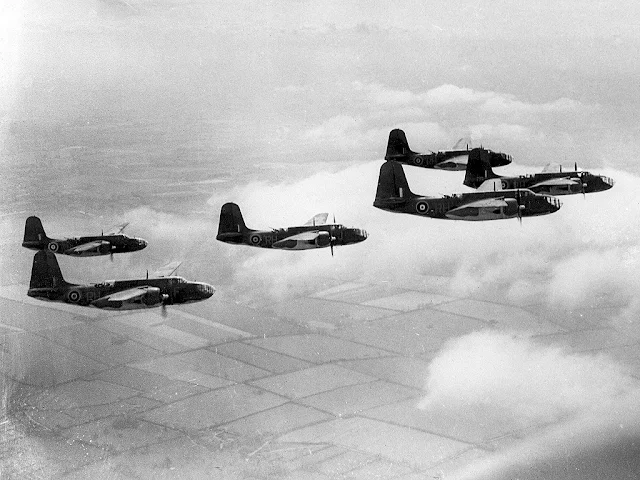 |
| Douglas A-20 Boston. The RCAF flew three at Suffield, Alberta, for "special" research operations. |
 |
| Douglas Boston Mk. III, RCAF No. 418 Squadron, circa 1944. |
 |
| Douglas Boston Mk. III (Intruder) (Z2240 TH-T) "Toronto", No. 418 (Intruder) Squadron, RCAF, circa November 1941-July 1943. |
 |
| Douglas Boston, H for Humboldt, Saskatchewan, RCAF. |
 |
| Douglas Boston, H for Humboldt, Saskatchewan, RCAF. |
 |
| Douglas Boston formation, RCAF. |
 |
| Douglas Boston Mk. III formation, No. 418 (Intruder) Squadron, RCAF, circa 1941-1943. |
 |
| Douglas Boston Mk. III, No. 418 (Intruder) Squadron, RCAF, "B" Flight, taken at their home, RAF Station Debden, Essex in the UK, February 1942. |
 |
| Douglas Boston Mk. III (W8358), No. 418 (Intruder) Squadron, RCAF, at RAF Debden, England. |
 |
| Douglas Boston Mk. IV (W8268, TH-O, "Ottawa, Ontario"), No. 418 (Intruder) Squadron, RCAF, circa November-December 1941. |
 |
| Douglas Boston Mk. IV (W8268, TH-O, "Ottawa, Ontario"), No. 418 (Intruder) Squadron, RCAF. |
 |
| Douglas Boston pair, No. 418 (Intruder) Squadron, RCAF, 14 May 1943. |
 |
| Douglas Boston aircraft of No 24 Squadron, South African Air Force lined up at Zuara, Tripolitania. The nearest is AL683/`V'. 1943. (Imperial War Museum TR 838) |
 |
| Dummy Havoc aircraft, October 1943. (The National Archives) |
 |
| Douglas DB-7 (Turbinlite) Havoc NF.II (Z2184), Boscombe Down, c. 1943. (Imperial War Museum MH5710) |
 |
| Douglas Boston, RAF, January 1943. (Library of Congress 2017696116) |
 |
| Douglas Boston, RAF, January 1943. (Library of Congress 2017696103) |
 |
| Port Moresby, Papua, c. October 1942. A Douglas Boston bomber aircraft of No. 22 Squadron RAAF on the runway of the airfield at Port Moresby. (Australian War Memorial OG0060) |
 |
| Douglas Boston, RAF. |
 |
| Douglas Boston III. |
 |
| Douglas Havoc II, AH525, RAF. |
 |
| Douglas Boston III, YP-F, No. 23 Squadron, RAF. |
 |
| Douglas Boston III, factory-fresh on test flight. |
 |
| Douglas Bostons, No. 88 Squadron, RAF. Middle aircraft is RH-J. |
 |
| The Dieppe Raid, 19 August 1942. Bombs being released from a Douglas Boston bomber over the target area. (Imperial War Museum C3081) |
 |
| A Douglas Boston Mark III of No. 114 Squadron RAF takes off from rain-soaked Celone, Italy, along a runway laid with pierced steel planking (PSP). (Imperial War Museum CNA2690) |
 |
| Royal Air Force Douglas Boston Mark IIIs of No. 88 Squadron RAF, lined up at RAF Attlebridge, Norfolk (UK). The airfield was used by No. 88 Squadron RAF from August 1941 to September 1942. |
 |
| 'Evelyn', a No 23 Squadron Havoc 'fighter-bomber', starts up at Ford at the beginning of another night sortie, 28 November 1941. (Imperial War Museum CH4048) |
 |
| An infra-red photograph of a Douglas Havoc Mark I (Intruder) of No. 23 Squadron RAF, preparing to start up for a sortie at Ford, Sussex. (Imperial War Museum CH2777) |
 |
| Boston Mark III, AL775 ‘RH-D’, of No. 88 Squadron RAF based at Attlebridge, Norfolk, in flight. (Imperial War Museum CH5618) |
 |
| Douglas Boston Mark IIIs of No 88 Squadron RAF, lined up at Attlebridge, Norfolk. (Imperial War Museum CH5601) |
 |
| Ground crew testing the engines of a Douglas Boston Mark III of No. 88 Squadron RAF Attlebridge, Norfolk. (Imperial War Museum CH5599) |
 |
| Five Douglas Boston Mark IIIs of No. 12 Squadron SAAF, lined up ready for take off at Gzina/Sidi Azzab, Libya. (Imperial War Museum CM4677) |
 |
| A Douglas Boston Mark III of No. 12 Squadron SAAF raises the dust while opening up its engines for take off at Bir el Beheira, Libya. (Imperial War Museum CM2903) |
 |
| Douglas Boston Mark IIIs of No. 12 Squadron SAAF set off in loose formation on a bombing raid from their base at Bir el Beheira, Libya. (Imperial War Museum CM2912) |
 |
| The crew of Douglas Boston Mark III, W8376 'C', of No 24 Squadron, South African Air Force, walking away from their aircraft on an airfield in Libya after a sortie. (Imperial War Museum CM2079) |











































